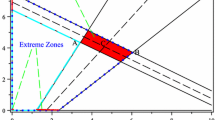Abstract
Interval programming techniques are a valuable approach for tackling uncertainty in mathematical programming models, because they only require the knowledge of the feasible range of variation of the model coefficients. Nevertheless, the use of these techniques has some limitations, namely when the number of decision variables with interval coefficients is high since the number of objective functions at stake in the sub-problem for testing the (weak) efficiency of each non-basic variable may be easily out of an acceptable computational effort. A similar problem may arise with the number of sub-problems for testing the multi-parametric optimality of each solution obtained (that is, to check whether the solution is possibly optimal or not) and the multi-parametric optimality of each edge by using the all emanating edges algorithm. An alternative algorithm is suggested that allows obtaining all possibly optimal solutions, which fulfill the formal criteria of optimality in a feasible bounded region.
Similar content being viewed by others
References
Bazaraa MS, Jarvis JJ, Sheralli HD (1990) Linear programming and network flows, 2nd edn. Wiley, New York
Ida M (1999) Necessary efficient test in interval multiobjective linear programming. In: Proceedings of the eighth international fuzzy systems association world congress, pp 500–504
Inuiguchi M, Higashitani H, Tanino T (1999) On enumeration of possibly optimal extreme points in linear programming problems with interactive possibilistic variables. In: Proceedings of 7th European congress on intelligent techniques and soft computing. Aachen, Germany. CD Rom, CC5-312852_P.pdf
Inuiguchi M, Sakawa M (1994) Possible and necessary optimality tests in possibilistic linear programming problems. Fuzzy Sets Syst 67:29–46
Inuiguchi M, Sakawa M (1995) Minimax regret solution to linear programming problems with an interval objective function. Eur J Oper Res 86:526–536
Inuiguchi M, Sakawa M (1996) Possible and necessary efficiency in possibilistic multiobjective linear programming problems and possible efficiency test. Fuzzy Sets Syst 78:231–241
Oliveira C, Antunes CH (2007) Multiple objective linear programming models with interval coefficients – an illustrated overview. Eur J Oper Res 181(3):1434–1463
Oliveira C, Antunes CH (2009) An interactive method of tackling uncertainty in interval multiple objective linear programming. J Math Sci 161(6):854–866
Steuer RE (1978) Vector-maximum gradient cone contraction techniques. In: Multiple criteria problem solving. Lecture notes in economics and mathematical systems, vol 155. Springer, Berlin, pp 462–481
Steuer RE (1981) Algorithms for linear programming problems with interval objective function coefficients. Math Oper Res 6(3):333–348
Steuer RE (1986) Multiple criteria optimization: theory, computation and application. Wiley, New York
Acknowledgements
This work has been partially supported by projects PEst-C/EEI/UI0308/2011 and MIT/SET/0018/2009.
Author information
Authors and Affiliations
Corresponding author
Rights and permissions
About this article
Cite this article
Oliveira, C., Antunes, C.H. & Barrico, C. An enumerative algorithm for computing all possibly optimal solutions to an interval LP. TOP 22, 530–542 (2014). https://doi.org/10.1007/s11750-012-0268-2
Received:
Accepted:
Published:
Issue Date:
DOI: https://doi.org/10.1007/s11750-012-0268-2




